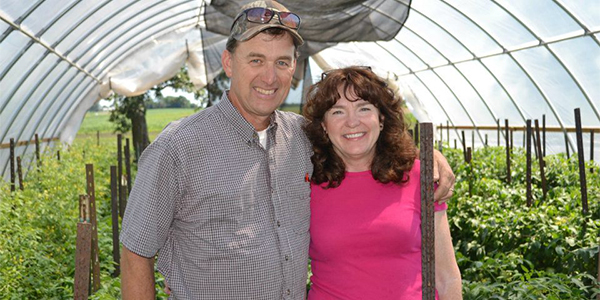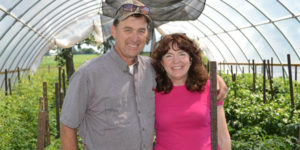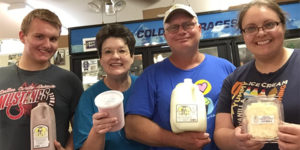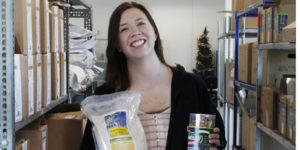
Local Foods Diversify, Boost Profits
Farmers are a curious and creative bunch, always on the lookout for ways to diversify their income stream and improve their bottom line.
Match that with a concern for the health of their communities and a nose for a developing market, and the result is a growing local foods economy benefiting producers, consumers and the entrepreneurs who connect them.
Far from typical
Greg Rinehart (’74 animal science) and his wife Polly have raised 10 children on their 800-acre farm northwest of Boone, Iowa. The farm has put every one of their kids through college (the majority at Iowa State). But it’s not your typical Iowa grain farm.
Back in the 1980s, when the ag economy was floundering, Greg and Polly took a hard look at their 20-year-old commodity farm business and took a risk.

Greg and Polly Rinehart grow fruits and vegetables in addition to corn and soybeans, which Greg says helps with cash flow and soil health. They sell to Birdseye Vegetables and at the Boone and Des Moines Downtown Farmers’ Markets. (Contributed Image)
“We were growing corn, soy, cattle and hogs, and losing money on all of them,” Greg says.
In 1988, RAGBRAI passed by the farm, and a neighbor suggested Greg should raise sweet corn to sell to the hungry riders. The following year, the family began raising vegetables on about two acres for the brand-new Boone Farmers’ Market. Nearly 30 years later, the farm produces sweet corn and early peas on 400 of its acres, for sale to Birds Eye Vegetables for its microwave frozen food line. They still produce corn and soybeans on 400 acres.
The Rineharts also are raising, “just about any vegetable you can grow in Iowa” for sale at the Boone and Des Moines Downtown Farmers’ Market.
Greg credits Iowa State faculty and staff with ongoing technical assistance and support, and names Ajay Nair, professor of horticulture, and the staff of the horticulture station as especially helpful. He looks forward to passing on the farm to his son Daniel in due time.
He’s got a bit of advice for other farmers looking to diversify into horticulture. “We started slow, and that’s the best plan,” Greg says. “Grow the things you like to grow, and that will sell. You can expand your business from there.”
Growing impact
The most recent statewide survey data collected by Iowa State University shows farmers like the Rineharts are contributing to Iowa’s growing horticulture industry. In 2015 horticulture generated $48.3 million in direct sales, of which $32.1 million are payments to value-added enterprises (including labor income, returns to farm owners and investors and tax payments). Of this, 503 jobholders earned $21.4 million in labor income, which is earned and spent locally.
The potential exists for even more growth.
Iowans spend more than $8 billion on food each year, of which only about 14 percent is grown in the state. Research by Iowa State University economist David Swenson indicates increased production of fruits and vegetables could result in a corresponding increase in jobs and income for many Iowans.
In response to this opportunity, Iowa State has ramped up its investment in local food systems statewide by creating a local foods program within extension and outreach. Its staff of 10, under the direction of program manager Craig Chase (’80 MS agricultural economics, ’94 PhD rural sociology), supports local food systems in a number of ways.
The program offers the following resources:
- leadership training and professional development
- research-based, needs-driven tools and publications
- evaluation services and training
- facilitation and outreach services
- support for youth education in gardening and nutrition
- help building diverse coalitions and partnerships, locally and statewide
The 20-some local food systems practitioners currently serving 84 of Iowa’s 99 counties attest their work is benefiting their communities in multiple ways.
“Growing for local markets can provide a lower-cost point of entry into agriculture for beginners than larger scale, commodity-market farming,” Chase says. “Local food systems create other business opportunities for distributors and aggregators, keep dollars circulating in the community, give commodity growers a means of diversifying their income and help children and families connect to healthy, local food products.”
Adding value on farm
When Jill and Jeff Burkhart of Picket Fence Creamery built a grade-A bottling plant at their 80-acre dairy farm near Woodward, Iowa, in 2003, they were aiming to bring some balance to their family life.
“Jeff and I both had fulltime jobs off-farm and had the dairy farm as well,” Jill says. “We needed to find a way for the dairy to make money on a stable basis, or stop the dairy and do our jobs in town. We both decided we wanted to keep the farm going, make it sustainable for us, and make a living for our family.”

The Burkhart family, James, Jill, Jeff and Jenna (left to right), built a bottling plant at their 80-acre dairy farm near Woodward—Picket Fence Creamery. They teamed up with professors at Iowa State to involve students in producing their business plan and marketing and feasibility study.
The timing was right for a value-added dairy business in the central Iowa area, so Picket Fence Creamery stepped in to meet demand for a local dairy product line and has continued to grow with consumer demand.
With several Iowa Staters in the family, the Burkharts turned to Iowa State University for assistance. They worked with students to produce a business plan as a team project, and another class did a marketing and feasibility study for the creamery.
The family-run creamery was bottling all of its own milk within the first nine months of operation. Since selling its first bottles of milk in the Perry HyVee, the creamery has grown to produce and distribute milk and chocolate milk, cheese and 30 flavors of ice cream to 80 locations statewide. They also sell their own beef and around 100 locally made food products from other vendors in their farm store.
Stephanie Clark, professor of food science and human nutrition at Iowa State, noted on-farm processing is a great way for small farmers to add value to their agricultural products—an important advantage in today’s marketplace.
“It’s difficult to make ends meet by just raising animals for milk production and sale of fresh milk,” Clark says. “Farmers can recoup more of their investment and have the creative satisfaction that on-farm value-added processing provides.”
Connecting farm to table
FarmTable Procurement and Delivery of Harlan, Iowa, is an aggregator and online marketplace of locally produced foods. Ellen Walsh-Rosmann (’09 public service and administration in agriculture, international agriculture) and her husband Daniel Rosmann (’05 agronomy) created the business in 2013 to meet a growing demand from local chefs for fresh products. Business has boomed, and now includes a crowd-funded delivery truck, a growing staff and a business park location for aggregation and storage.
FarmTable distributes products from about 45 farmers to 80-90 buyers such as chefs, grocery stores and buying clubs in the Omaha, central Iowa and Cedar Rapids/Iowa City food sheds.

CALS grads Ellen Walsh-Rosmann and her husband Daniel Rosmann created FarmTable Procurement and Delivery in Harlan, Iowa, to meet a growing demand from local chefs for fresh products. (Contributed Image)
“As a farmer, I know it isn’t easy to sell and scale up a farm for the wholesale market,” Ellen says. “We started FarmTable to help our farmer friends.”
Danelle Myer is one of those friends— the owner-operator of One Farm, a small vegetable business near Logan, Iowa, and a satisfied FarmTable client.
“What I appreciate most about FarmTable is the way its system allows me to not only stay on farm to grow, harvest and package orders, but it also allows us to reach markets and build customer relationships we would never have time to cultivate on our own,” Myer says.
Iowa State’s Swenson suggests smart public policies connecting local farmers to large food buyers such as supermarkets, restaurants, hospitals and school districts could help grow midsize farms, creating jobs and boosting local economies.
Capitalizing on growing consumer demand for locally grown food is one way farmers may diversify. The Iowa State University Extension and Outreach Local Foods Program offers tools, resources and expertise to help along the way.
##
Find ISU Extension and Outreach local food resources and visit the farms featured online:



